Unexploded ordnance facts for kids

Unexploded ordnance (often called UXO or UXBs) are bombs, shells, grenades, or other explosive weapons that were used but did not explode. They are still very dangerous and can go off many years after they were first used. Sometimes, these old explosives are found and safely destroyed by experts. But sometimes, they explode by accident, which can cause serious harm or even death.
For example, UXO from World War I (which ended over 100 years ago!) can still be found and are dangerous. Some even contain poisonous gas. UXO isn't just from wars, though. Military training areas can also have a lot of unexploded items, even after the training stops.
Landmines are a type of UXO. They are found in 78 countries and injure or kill about 15,000 to 20,000 people every year. Most of these people (about 80%) are civilians, meaning they are not soldiers. Children are often the most affected group. Sadly, about half of the people who are hurt by landmines die within hours of the explosion. In recent years, landmines have sometimes been used to scare local people.
Besides the danger of exploding, buried UXO can also harm the environment. In places where the military trained a lot, chemicals from explosives can get into the soil and groundwater. This can pollute the area.
What Makes UXO Dangerous?

Unexploded ordnance, no matter how old, can still explode. Even if it doesn't explode, harmful chemicals can leak out as it breaks down over time. Finding and removing deeply buried UXO is very hard and risky. Even a small bump can make it explode. Once found, explosives can sometimes be moved safely to a place where they can be destroyed. If not, they have to be blown up right where they are found. This sometimes means hundreds of homes need to be emptied for safety.
UXO from as far back as the mid-1800s is still a risk around the world. This includes places where battles happened and old military training grounds. A big problem is that over many years, the parts inside the bomb that make it explode can get old and become even more sensitive. This makes them more dangerous to touch.
Building new things can sometimes uncover old, unexploded bombs, which might then explode. Forest fires can get worse if buried bombs explode from the heat. Also, very hot weather can make water levels drop, which might expose bombs that were hidden underwater. There are many stories of people touching old UXO, often with very bad results. Because of this, it is always advised that people who are not trained experts should never touch or move unexploded ordnance. Instead, you should tell the local police right away. They will send bomb disposal experts to make the area safe.
UXO and International Rules
There are international rules about unexploded weapons. For example, something called Protocol V of the Convention on Certain Conventional Weapons says that when a war ends, the groups involved must clear the areas they control of "explosive remnants of war." Landmines have similar rules under Protocol II. These rules help make sure that areas are made safe after fighting stops.
How Experts Find UXO
Many unexploded bombs, especially those dropped from planes, are found during construction work. They might have been hidden underground for decades. Just because a bomb hasn't exploded yet doesn't mean it won't explode if it's disturbed. Finding these bombs is common in cities that were heavily bombed in the past.
In places where a lot of UXO is known to be buried, experts first look at old aerial photos to see if they can spot anything. Today, they also use special tools like electromagnetic and magnetic detectors. These tools help create digital maps of where UXO might be. This helps them know exactly where to dig, which saves money and speeds up the clearing process. Special magnetometer probes can find UXO and gather information about the ground before any drilling or digging is done.
In the U.S., programs like SERDP and ESTCP fund research to find better ways to tell the difference between UXO and just regular scrap metal. A lot of the money spent on removing UXO goes to digging up metal that isn't actually a bomb. So, better ways to tell them apart will help make cleanup cheaper and faster.
Experts often classify UXO as either buried or unburied. A special team will check the area to find where the ordnance is. If it's not buried, they might carefully dig it up and get rid of it. But if the bomb is buried, it's a much bigger job. A team uses metal detectors to find the exact spot, and then they carefully dig it out.
See also
 In Spanish: Municiones no explotadas para niños
In Spanish: Municiones no explotadas para niños
- Ammunition dump
- Delay-action bomb
- Ordnance

